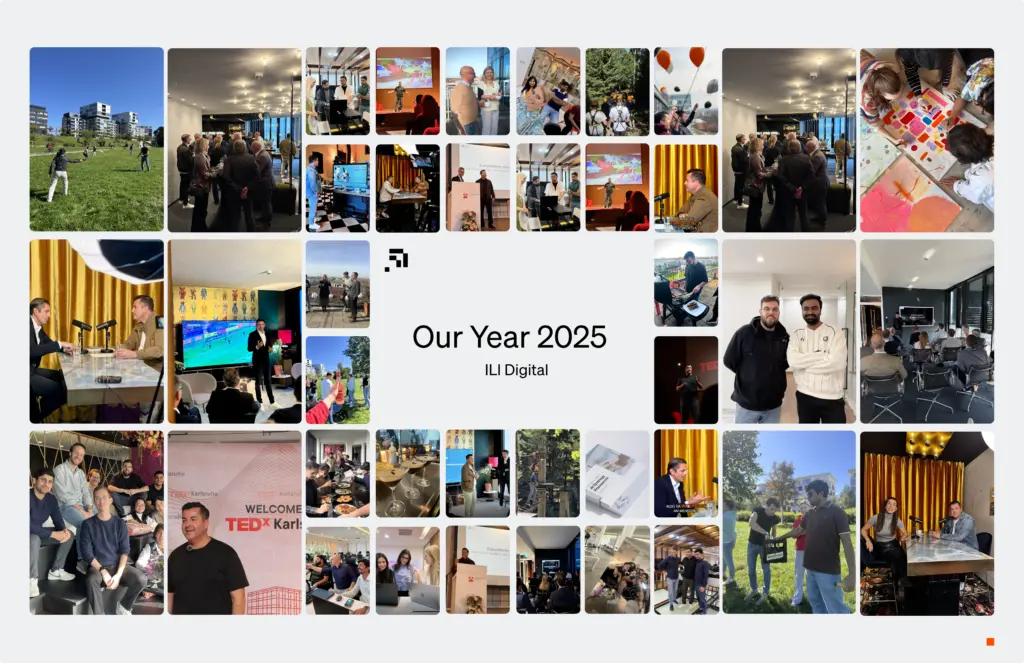We met with Serhan Ili, CEO and Founder of ILI.DIGITAL, at an historic hotel with authentic 1970s interior design, to discuss opium for management, scarcity of ambition and opportunity intelligence.
Sitting here, you really get a feeling of how much has changed in the past 50 years. I think it’s important to see where we have come from, it can fuel our ambition for the future.
The benchmarks of today will never be enough for developing the future to come. But a look in the past can sometimes enable us to see what we are capable of!
Germany, the land of inventors
So the ambitions of the present won’t stand the test of time? For example, did Germany miss the early train for monetizing its innovations?
Germany is still known as the land of inventors and developers. Even though our ideas are respected everywhere, economic exploitation rarely happens in our own country.
How can that be? Perhaps it’s not only about possessing the ability, but more about execution. Or perhaps because the one who cultivates an idea is the innovator, not the one who had the idea in the first place. If we don’t lack innovators, then we lack something else: entrepreneurs.

Because anyone who does not watch the market, will stop seeking out opportunities and new paths, and forget to pursue that which secures the future.
Dr. Serhan Ili
Where do you see the biggest problems in the process?
The problem’s at the top – and I’m not the only one bearing this opinion. A new study done by IMD, the Swiss business school, found that Germany is no longer among the top ten competitive nations worldwide, having slipped from sixth place in 2014.
This survey of over 5,400 managers looked at 342 criteria and concluded that self-satisfaction poses the biggest risk for Germany. Who should we blame for this, if not management? It was hard for me to suppress this thought of blame, as I listened to the head of innovation at one of the big pharma corporations in Germany telling me that the latest innovation they had just patented would be a guaranteed cash cow for the next decade, and that they could now enjoy a hiatus in the development pipeline for a while.

Self-satisfaction, opium for the management
What would happen if they really went through with this?
That would be disastrous – because anyone who does not watch the market, will stop seeking out opportunities and new paths, and forget to pursue that which secures the future. Hence, the first priority of management is to incite ambitions in this arena.
Where should companies be driven at the moment?
A side comment to start with about how risk-averse thinking is increasingly replacing entrepreneurship: when working for corporations and SMEs, we find that many start-ups seek security under the roof of big companies. They give up their agility, freedom of choice, and quite often their vision too by tying up with powerful, oppressive organizations.
Start-ups in the U.S., especially in the Silicon Valley, are different: they believe in their dynamism, and are convinced that only they can determine how to stay ahead of the pack. There’s no need to compare figures to realize where ambition and entrepreneurial spirit are greater.
Like in the U.S.?
I am forever excited by the major, particularly novel successes in the U.S., where the level of appreciation is disproportionately greater than in Germany. Do we envy or belittle this frequently courageous coup de main? Not really!
This survey of over 5,400 managers looked at 342 criteria and concluded that self-satisfaction poses the biggest risk for Germany. Who should we blame for this, if not management? It was hard for me to suppress this thought of blame, as I listened to the head of innovation at one of the big pharma corporations in Germany telling me that the latest innovation they had just patented would be a guaranteed cash cow for the next decade, and that they could now enjoy a hiatus in the development pipeline for a while.
Opportunity intelligence – Recognize the signs
In terms of revival, some have realized that storm clouds are gathering. Yet, many of the responses still reek of self-satisfied sedateness: German innovation is preferably incremental. This is simply playing by the rules!
There’s nothing wrong with cutting consumption by 5% or boosting content by 2%. The problem is that this easily shifts the focus from what really counts: a big jump forward, or something really novel. As such, enterprises begin to feel they are active, whereas in reality they are simply at the stage preceding a full innovation coma.
If at the end one recognizes the hopelessness of the path they treaded forever, the resources needed for starting anew will have practically vanishe
What exactly would need to change in Germany?
The concept of innovation doesn’t appear to have taken root in many parts of Germany. One often encounters signs of real physical rejection – justified psychologically: innovation departments pursue a fig leaf existence. They are isolated, short-staffed, on tight budgets, and lack a proper network with development departments, and especially with management. The efforts made here tend to wallow in open space. Yet, innovation is still called a top priority! But then why are there so few captains here at the helm?
For a lasting future, everyone must be open to change. This includes revising business models, organizations, and roles. The problem lies in the German management culture’s difficulty in letting go of old, reliable structures and power dynamics. The fear of failure and criticism, particularly from those comfortable within the old systems, makes this change seem almost impossible. “Entrepreneurs are never famous for managing a poor status quo – instead, they are known for enabling innovation to blossom.”
ILI mission statement
Your mission statement on your website is “We make corporates entrepreneurs again” – could you explain that to us?
It’s never easy to be the captain. Yet, if pioneering enterprises prefer to manipulate software instead of innovating, even the last one should realize that time’s running out. Entrepreneurs are never famous for managing a poor status quo – instead, they are known for enabling innovation to blossom. We need entrepreneurs who can do that, entrepreneurs defined by three criteria: opportunity intelligence, selection certainty, and willpower.
You either have it or you don’t – i.e., the ability to see the signs of blue oceans in our market economy. One could, of course, say that it doesn’t always have to be the big coup.
Acting on opportunity intelligence means having an alert mind to sniff out potentially new developments. Such opportunities often lie at the crossroads of technologies and sectors. Looking beyond corporate boundaries and linking up with approaches, expertise, and technologies way past them opens up new markets and competitive advantages.
This was how Trumpf, the manufacturer of machine tools, lasers, and electronics, saw the opportunity early on in Digitization and Industry 4.0. Now, Trumpf develops its own software to network and plan production processes and machines, and is looking into extending these to all kinds of other enterprises as cloud-based offers for smart factories of the 21st century.
Willpower success follows passion
Innovation is a process that requires a wealth of ideas, and one needs to select promising projects from that pool.
Recently, we helped a big corporation select innovative ideas from among 700 which generated over an 18-month corporation-wide initiative. However, since then the ideas are gathering dust, employee enthusiasm is dwindling, and the innovation department is overstretched. Are we missing an entrepreneur?
Innovation is a process that requires a wealth of ideas, and one needs to select promising projects from that pool. Let’s take BMW as an example: management took the bold decision to kick-off ‘Project i’ early on to invest in electromobility – in spite of foreseeably modest sales figures. This wasn’t a mistake. The technological learning curve and the boost from a positive image will pay back with a sustained market value. Yet, we prefer to focus on certainty, rather than on daring, whenever enterprises actively choose new paths and shape the future.
The Senior V.P. of innovation at one of the world’s largest consumer goods manufacturing corporations recently told me in a resigned tone that they will be twiddling their thumbs for the next nine months: no landmark innovation decisions until the new CEO is on board, and that too at all levels of hierarchy. In contrast, the CEO of an SME client of ours cut through red tape in his team, saying, “I quickly made a decision and approved product development. There was too much discussion and too little gusto.” Far too often, our leadership lacks such unconditional determination.
So it’s not impossible…
If management is right and really wants innovation, it can easily create the necessary forces to eliminate inflexible structures. Willpower is key, not only in execution but also in searching and selecting driving forces for success. If management is committed to innovation, they can overcome inflexible structures and resistance. Being part of a successful innovation process sparks enthusiasm and loyalty.
But the decision must come from the top. If German companies can establish an innovative culture, they can transition from a land of inventors to a land of innovators. If not, our status as a land of inventors may soon be history.




